The AMD Trinity Review (A10-4600M): A New Hope
by Jarred Walton on May 15, 2012 12:00 AM ESTAMD Trinity Gaming Performance
After the 3DMark results, you might be wondering if Intel has finally caught up to AMD in terms of integrated graphics performance. The answer is…yes and no. Depending on the game, there are times where a fast Ivy Bridge CPU with HD 4000 will actually beat out Trinity; there are also times where Intel’s IGP really struggles to keep pace. The good news is that at least everyone is now onboard the DX11 bandwagon, and compatibility with games has improved yet again for Intel. Here are our “Value” benchmark results for seven recent games; we’ll have more information in a moment.

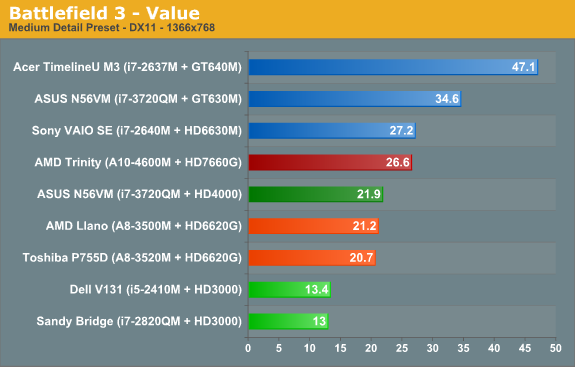
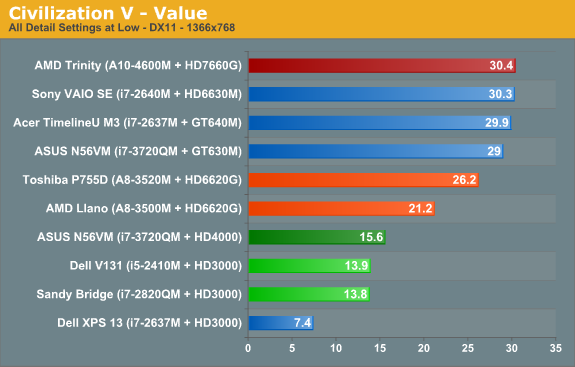

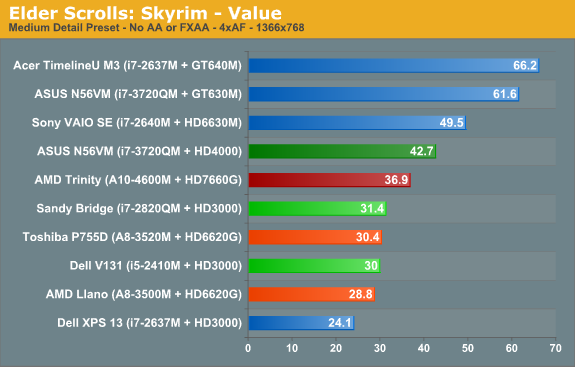
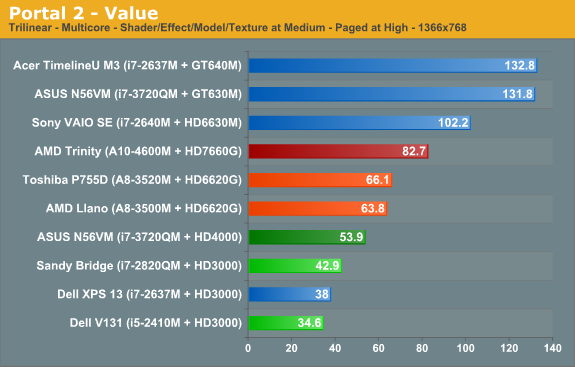
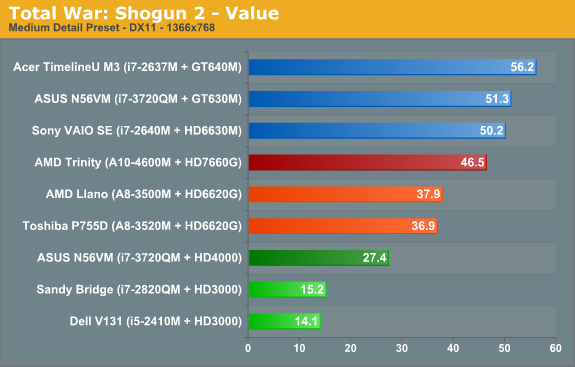
Out of our seven test titles, AMD’s Trinity leads any other IGP in four titles by a large margin. The other three titles actually have Ivy Bridge slightly ahead of Trinity, but the gaps aren’t nearly as big. Overall, the average performance across the seven games at our Value (medium) settings has AMD’s Trinity A10-4600M leading Intel’s i7-3720QM by 21%, and if we look at quad-core Sandy Bridge with HD 3000 (i7-2820QM) Trinity is 72% faster. Trinity is also around 20% faster than 35W Llano on average.
Let’s expand our gaming suite just a bit to see if things change, though. Just like we did with Ivy Bridge, we ran the eight games in our previous benchmark suite at medium detail settings. We can then compare performance across a wider 15 title selection to see how Trinity matches up against HD 4000, HD 3000, and HD 6620G (Llano). We’ll start with the bottom (HD 3000/Sandy Bridge) and move up.
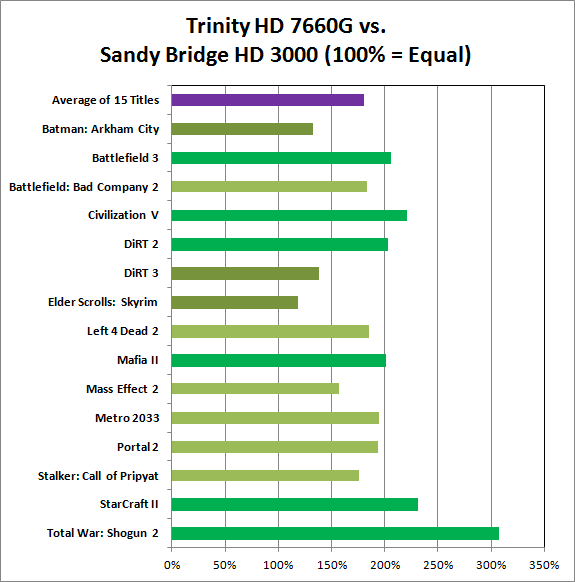
Llano’s HD 6620G was already faster than HD 3000, and Trinity’s HD 7660G is faster than Llano, so the Sandy Bridge gaming matchup is a landslide victory in AMD’s favor. The closest Intel can get is in the same three titles where Ivy Bridge leads Trinity: Batman: Arkham City, DiRT 3, and Skyrim. Here, however, HD 3000 can’t actually close the gap and HD 6620G is at least 20% faster than HD 3000, with an average performance improvement of nearly 80%.
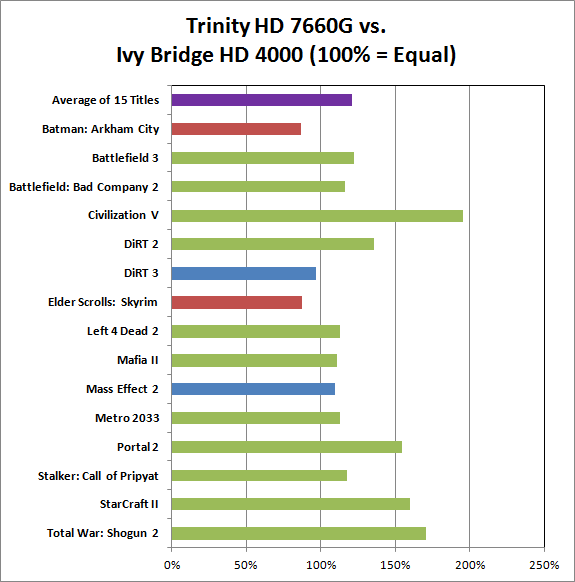
We found that across the same selection of 15 titles, Ivy Bridge and Llano actually ended up “tied”—Intel led in some games, AMD in others, but on average the two IGPs offered similar performance. This chart and the next chart will thus show a similar average increase in performance for Trinity, but the details in specific games are going to be different. Starting with Ivy Bridge and HD 4000, as with our earlier game charts we see there are some titles where Intel leads (Batman and Skyrim), a couple ties (DiRT 3 and Mass Effect 2), and the remainder of the games are faster on Trinity. Mafia II is close to our <10% “tie” range but comes in just above that mark, as do Left 4 Dead 2 and Metro 2033. The biggest gap is Civilization V, where Intel’s various IGPs have never managed good performance; Trinity is nearly twice as fast as Ivy Bridge in that title. Overall, it's a 20% lead for Trinity vs. quad-core Ivy Bridge.
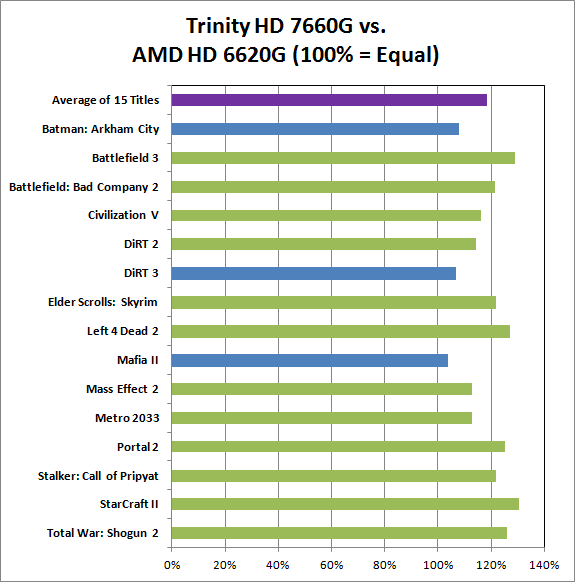
Against Llano, Trinity is universally faster, but the smallest gap is in Mafia II (3%) while the largest gap is in StarCraft II (30%). On average, looking at these games Trinity is only 18% faster than Llano. What’s not entirely clear from the above chart is whether we’re hitting CPU limitations, memory bandwidth limitations (remember that Llano and Trinity share bandwidth with the rest of the system), or perhaps both. At our chosen settings, what is clear is that Trinity’s “up to 56% faster” graphics never make it that high.
We saw 35-45% higher scores in 3DMark 11 and Vantage, which tend to remove the CPU from the equation more than actual games, so our guess would be that if AMD continues with their APU plan they’re going to need to work more on the CPU side of the equation. We also see the same thing looking at the VAIO SE scores in the earlier gaming charts: the HD 6630M scores are 20% faster on average, but much of that appears to come from the faster CPU rather than the GPU.










271 Comments
View All Comments
meloz - Tuesday, May 15, 2012 - link
Quiet underwhleming. :\On the CPU side, IVB absolutely clobbers Trinity. People keep saying [FONT="Arial Narrow"]"CPU don't matter"[/FONT], but if you have a SSD the 'bottleneck' immediately shifts back to the CPU for certain tasks. It is always nice to have good single thread performance, and Intel enjoys a huge advantage in this area.
On the iGPU side, the much derided and seemingly impotent HD 4000 manages to actually narrow the lead AMD enjoyed on the graphics side. If only Intel drivers were written by people who had any clue, they would get even better performance out of their silicon.
So it will all come down to pricing. This is as much in Intel's hand as AMD's. AMD can potentially sell a lot of these things, but at a price where they won't be making any profits.
Congratulations to JW on another fine review, but a very underwhelming new product from AMD, as I said earlier.
jabber - Tuesday, May 15, 2012 - link
Trust me, no one applauds if I hold up my laptop and shout "BEHOLD THE WONDEROUS SINGLETHREADED PERFORMANCE! BASK IN IT'S POWER!!!"You are making too much of too little really.
meloz - Tuesday, May 15, 2012 - link
"You are making too much of too little really. "The marketshare and sales performance of the two rival products immediately proves you wrong. But keep digging the hole. Need a Bulldozer (or is it time for an Excavator) to speed up the processs?
jabber - Tuesday, May 15, 2012 - link
You're right, I'm obviously just not taking the issue as seriously as you are.Enjoy the endless benchmarking!
Ahem....
Taft12 - Tuesday, May 15, 2012 - link
AMD can't produce enough chips to meet demand and is improving marketshare every quarter. Their <1% quarterly increases are more like digging with a spoon, but it's digging in the right direction.medi01 - Thursday, May 17, 2012 - link
Market share means nothing, silly. Prescott had much bigger share than Athlon 64, while being inferior on all fronts.Spunjji - Wednesday, May 16, 2012 - link
Who's deriding the HD 4000? :/medi01 - Thursday, May 17, 2012 - link
If you have SSD bottleneck is your brain, that is too slow to distinguish between 22ms and 24ms.There is no way 20% faster version of an ALREADY SUCCESSFULL product is "underwhelming".
cjs150 - Tuesday, May 15, 2012 - link
Am aiming to start an HTPC build in the next couple of months. Mostly for movies but a little light gaming from time to time (Total War: Shogan on a 47" HD screen!)Low power of Trinity looked very promising...then I read Jarred's review.
Back to the i7-3770T even though the CPU+motherboard will be at least twice the price of the AMD versions.
Assimilator87 - Tuesday, May 15, 2012 - link
The desktop version of Trinity should fare better because of the TDP headroom, although it's extremely disappointing that it won't be released 'till Q3. I guess my mini-ITX case will have to sit in its box for another few months.